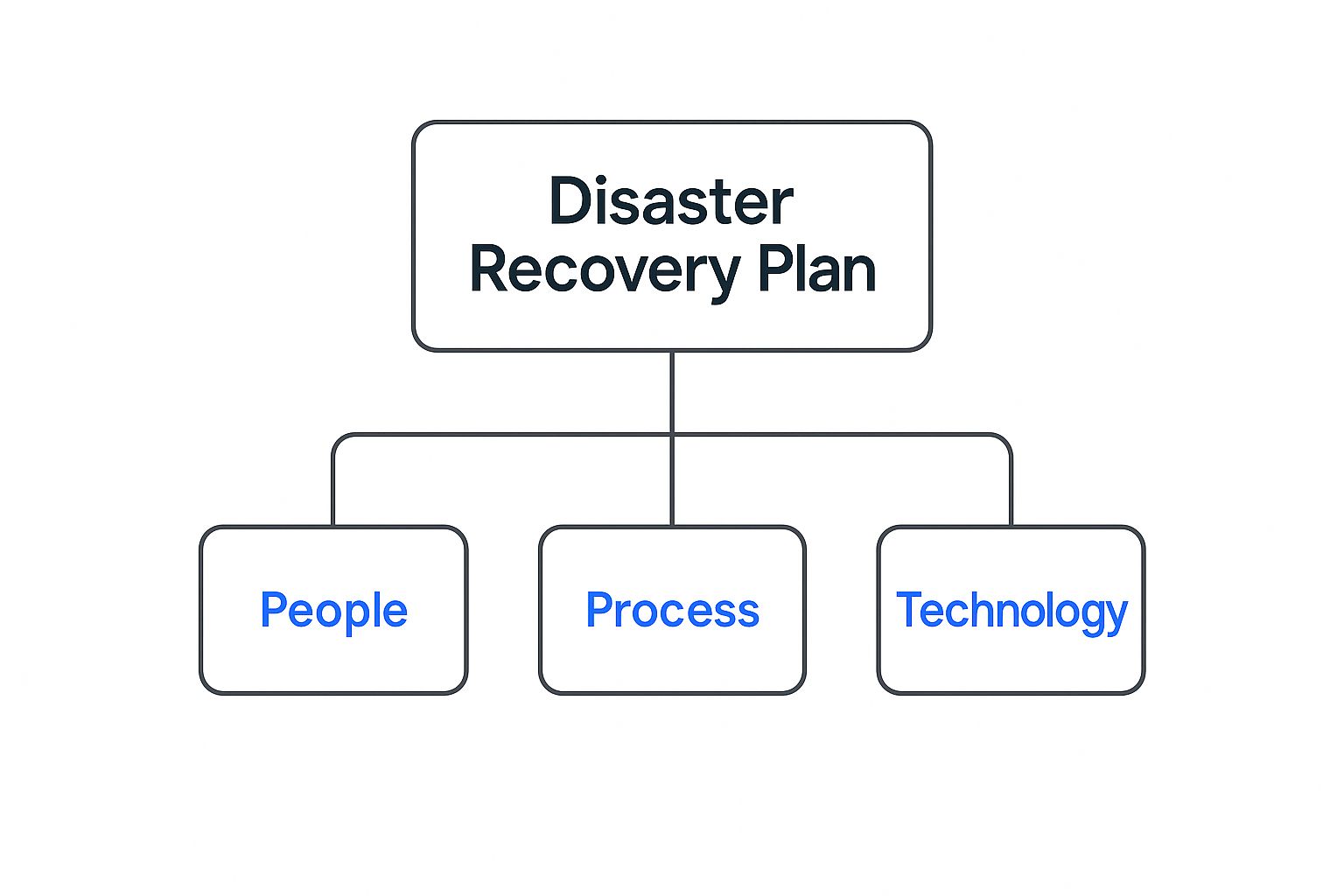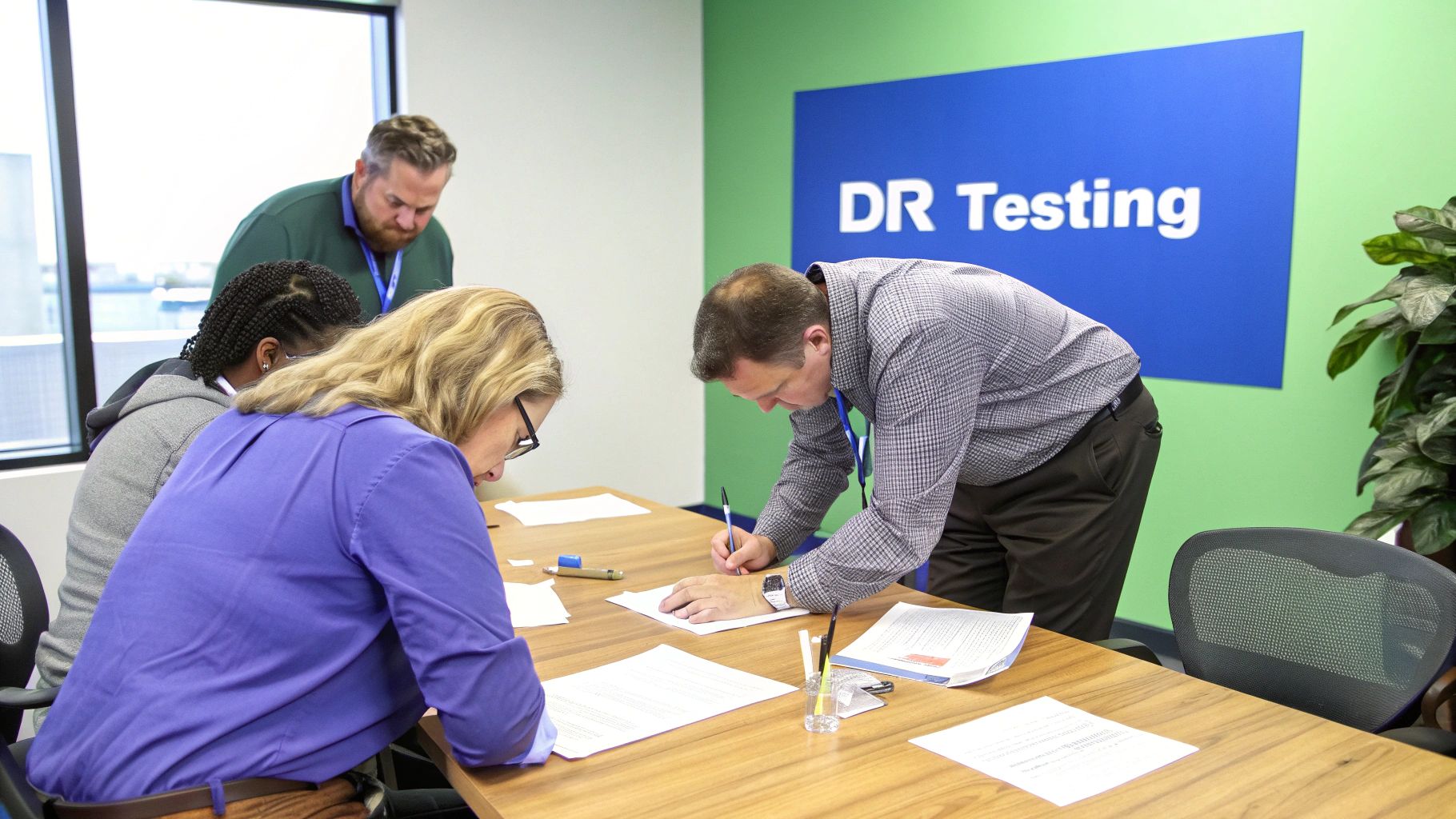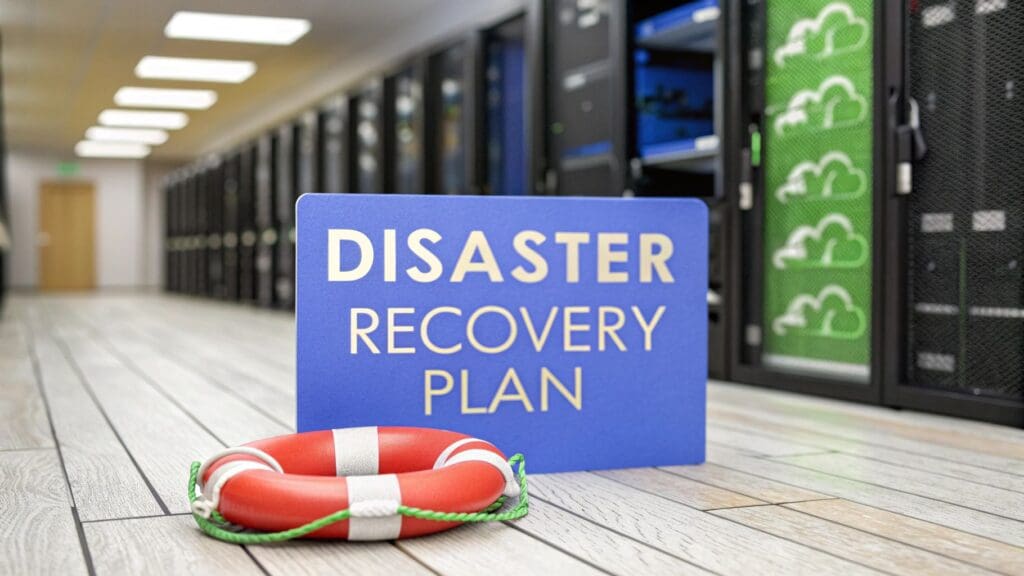Let’s get one thing straight: when we talk about disaster recovery (DR), we’re not just talking about having a backup of your files somewhere. That’s a common mix-up, and it’s a dangerous one.
If your business is a high-performance car, then data backups are the spare tyre in the boot. A full-blown disaster recovery plan? That’s the entire pit crew, the garage, the spare engine, and the step-by-step instructions to get you back in the race after a catastrophic crash.
What Is Disaster Recovery, Really?

While having backups is absolutely essential, it's just one piece of a much bigger, more important puzzle. A true disaster recovery plan is a documented, tested strategy that outlines exactly how your business gets back on its feet after something goes wrong.
It’s about operational continuity, not just data restoration. The plan answers the critical questions: who does what, which tools do they use, where do they work from, and in what order do things need to happen to minimise downtime and keep the business running?
Defining a 'Disaster' in Business Terms
The word ‘disaster’ probably brings images of floods, fires, or major cyber-attacks to mind. And yes, those count. But in the world of business, a ‘disaster’ is any event that grinds your normal operations to a halt.
These incidents are far more common than you might think. A disaster could be a key server failing the day before a huge client deadline. It could be a team member accidentally wiping a shared project folder. Or it could be a ransomware attack that encrypts every single file your agency owns, effectively holding your business hostage.
A robust DR plan has to account for this entire spectrum of threats, from the mundane to the catastrophic.
It’s a huge misconception that only large-scale events qualify as 'disasters.' The reality is that over 40% of businesses face data loss from everyday issues like hardware failure, human error, or software corruption. These are precisely the scenarios a solid DR plan is built to handle.
Disaster Recovery vs. Backups at a Glance
To clear up any confusion, it helps to see the two side-by-side. Backups are a component; disaster recovery is the comprehensive strategy.
| Aspect | Data Backups | Disaster Recovery Plan |
|---|---|---|
| Purpose | To create copies of data for restoration. | To restore full business operations and infrastructure. |
| Scope | Just the data itself. | Data, systems, applications, people, and processes. |
| Goal | Recovering lost or corrupted files. | Minimising downtime and financial impact. |
| Activation | When a file or dataset is lost. | When a significant disruptive event occurs. |
Ultimately, having a DR plan is a fundamental pillar of business resilience. It shifts your mindset from reacting to a crisis to having a pre-agreed, practiced strategy ready to go. Because when-not if-an incident occurs, you’re not just risking data; you’re risking your projects, your client relationships, and your entire reputation.
The Building Blocks of a Strong DR Plan
A solid disaster recovery strategy isn’t a single document you write once and forget. It’s a living, breathing collection of interconnected parts. Each piece has a specific job, and they all have to work together to create a smooth, effective response when things go wrong. Getting to grips with these building blocks is the first real step towards building genuine resilience for your agency.
The whole process kicks off with a Business Impact Analysis (BIA). This is the bedrock of your plan. It’s where you identify the absolute most vital functions of your agency-the operations that must keep running for you to survive. Without this clarity, any recovery effort is just a shot in the dark.
Once you know what’s most important, the next step is a Risk Assessment. This is where you pinpoint the specific threats that could knock those critical functions offline, from a server failing to a local flood. By identifying where you’re vulnerable, you can start plugging the gaps before disaster strikes.
As this diagram shows, a successful DR plan isn’t just about the tech; it’s a careful balance of three core pillars: People, Process, and Technology.

The diagram makes it clear that fancy hardware alone won't save you. Your strategy needs the right people and organised processes to actually work when you need it most.
Defining Your Recovery Objectives
With your critical functions and biggest risks identified, you need to set your recovery targets. This is done using two key metrics that define the speed and thoroughness of your recovery.
A lot of jargon gets thrown around here, but it boils down to two simple questions: How fast do we need to be back online, and how much data can we afford to lose? These questions are answered by the RTO and RPO.
| Metric | What It Measures | Simple Analogy |
|---|---|---|
| Recovery Time Objective (RTO) | The maximum acceptable downtime for a system after a disaster. | Think of it as your stopwatch. If your RTO is 2 hours, you’ve failed if your system is still down after 121 minutes. |
| Recovery Point Objective (RPO) | The maximum amount of data loss your business can tolerate. | This is like your "rewind" button. An RPO of 1 hour means your backups must be recent enough that you never lose more than 60 minutes of work. |
These two metrics are the real engine of your DR plan. They transform a vague goal like "get back online" into something measurable and actionable.
These two metrics-RTO and RPO-are the heart of any disaster recovery plan. They transform a vague goal of "getting back online" into a measurable, actionable strategy that guides every technical and procedural decision you make.
Finally, a plan is useless if it just sits in a drawer. You need a dedicated DR team with crystal-clear roles, a communication plan for clients and stakeholders, and a commitment to regular testing. A plan that hasn’t been tested is just a theory.
For those looking to build or refine their DR strategy, using a complete Business Continuity Plan template and guide is a great way to structure your efforts. For more focused guidance, our disaster recovery plan IT template offers a framework designed specifically with creative agencies in mind.
Choosing Your Disaster Recovery Solution

There’s no one-size-fits-all approach when it comes to disaster recovery. Choosing the right path means striking a careful balance between your operational needs-those RTO and RPO targets we talked about-and what your budget can realistically handle. The options stretch from old-school physical sites to incredibly flexible cloud services.
Traditional methods usually involve bricks, mortar, and a lot of hardware. A cold site, for example, is basically an empty office space you can move into after a crisis. The catch? You have to bring and set up all your own equipment, which makes for a low-cost but painfully slow recovery. An often-overlooked part of this physical strategy is having reliable backup power solutions to keep things running during an outage.
The Rise of Cloud-Based Recovery
These days, modern solutions have moved recovery out of physical buildings and into the cloud, making top-tier DR accessible to almost everyone. The standout model here is Disaster Recovery as a Service (DRaaS). Think of it like having an expert recovery team and a fully kitted-out second office on standby, all paid for with a simple subscription.
A DRaaS provider essentially mirrors your entire IT setup-servers, data, applications, the lot-to their secure cloud. If disaster strikes your main office, you simply "failover" to this cloud copy and carry on working with minimal fuss.
This model has become hugely popular because it gets rid of the need for massive upfront spending on a second data centre and all the hardware that goes with it. The numbers back this up. In the UK, the DRaaS market was worth USD 952.4 million in 2023 and is expected to rocket to USD 4,453.6 million by 2030.
Finding Balance with Hybrid Models
For some businesses, a hybrid model hits the sweet spot. This approach mixes on-premises systems for everyday control with cloud-based recovery for that extra layer of resilience.
You might, for instance, keep your most critical data backed up locally for quick restores of minor issues, while relying on a DRaaS provider for a full-blown emergency. It’s a balanced strategy that gives you both hands-on control and a powerful safety net when you need it most.
Why a “One-Size-Fits-All” Disaster Recovery Plan Doesn’t Work for UK Businesses
If you’re running a business in the UK, grabbing a generic disaster recovery plan off the shelf simply won’t cut it. The unique risks and regulations we face here demand a much more localised approach. Understanding the basics is one thing, but tailoring your strategy to your immediate environment is what turns a plan into a lifeline.
One of the biggest local threats is something we’re all familiar with: the weather. Flooding is by far the most common natural disaster in the UK, posing a very real, physical risk to business premises and the local infrastructure they depend on. It’s not just a vague threat; UN data shows that floods are responsible for 35% to 40% of all weather-related disasters in our region. That statistic alone should be enough to make any business owner think twice about where their data is physically stored. You can explore the full UNDRR report to see the global risk assessments for yourself.
Navigating the UK’s Regulatory Minefield
Beyond the physical threats, UK businesses have to operate within a strict and complex regulatory framework. The rules around data, in particular, are non-negotiable.
The General Data Protection Regulation (GDPR) isn’t just about how you collect data-it dictates everything about how that data is stored, processed, and, crucially, recovered. A solid DR plan must ensure that any failover or restoration process remains fully compliant, especially when it comes to data sovereignty-the legal requirement to keep UK citizens' data within approved geographical locations.
Getting this wrong can be catastrophic. A non-compliant recovery process could land you with crippling financial penalties and do irreversible damage to your reputation, effectively turning a technical recovery into a legal nightmare. This is why choosing a DR provider who understands the local landscape isn’t just a preference; it’s a strategic necessity.
Ultimately, you can’t rely on outside help. Public confidence in national emergency preparedness is worryingly low, which puts the responsibility for resilience squarely on the shoulders of individual organisations. You have to assume that external support won’t be fast or comprehensive enough. Building your own robust, localised plan is the only dependable way to safeguard your operations, protect your client work, and keep your business running. For a deeper dive into the fundamentals, our guide on what is a disaster recovery provides the essential context you’ll need to start building your strategy.
The Real-World Benefits of a Tested DR Plan

A well-executed disaster recovery strategy delivers far more than just peace of mind-it provides tangible business advantages that resonate right up to the boardroom. The most obvious benefit is cutting down on costly downtime. Every minute your agency is offline means lost billable hours and blown deadlines.
But it goes deeper than that. A tested DR plan is a powerful tool for protecting your brand's reputation. When a crisis hits, being the agency that stays operational while competitors are scrambling sends a clear message. It’s how you build real customer trust and lasting loyalty.
Turning Precaution into a Competitive Edge
The advantages don't just appear during a crisis; they seep into your day-to-day operations. The process of creating a DR plan, especially the Business Impact Analysis (BIA) part, forces you to get a much clearer, more honest look at your own critical processes.
This knowledge often shines a light on operational weaknesses, leading to improvements and greater system stability long before a disaster ever strikes. Plus, having a proven plan can be a huge help in satisfying tough compliance and insurance requirements.
A robust disaster recovery plan is no longer just a defensive measure-it's a competitive advantage. It demonstrates a level of professionalism and foresight that reassures clients, satisfies regulators, and sets you apart in a crowded market.
Public confidence in widespread emergency preparedness is surprisingly low. Research shows that only 15% of UK adults believe the country is largely prepared for a disaster, which underscores why businesses need to take control of their own resilience. You can learn more about these UK preparedness findings and see why self-reliance is so crucial.
Ultimately, understanding what a disaster recovery plan is represents the first step, but actually implementing one is what secures your agency's future. For those ready to formalise their strategy, exploring a business continuity plan for IT is the logical next move.
Your Disaster Recovery Questions Answered
Even when the big picture makes sense, the practical side of disaster recovery can feel a bit fuzzy. Let's tackle some of the common questions that pop up, clearing the way so you can move forward with confidence.
Is Disaster Recovery the Same as Having Backups?
Not at all, though they are closely related. Backups are just copies of your data-an absolutely vital ingredient in your DR plan. But disaster recovery is the whole recipe: the people, the processes, and the technology needed to restore your entire business, not just your files.
Think of it like this: a backup is a spare tyre. Your DR plan is the jack, the lug wrench, and knowing how to change the tyre safely on the side of a busy motorway. One restores a single part; the other gets your whole business moving again.
How Often Should We Test Our DR Plan?
This really depends on how much risk your business can tolerate and how often your IT setup changes. As a rule of thumb, you should aim for at least one full-scale test every year. Smaller, more focused tests on specific systems should happen more frequently, maybe quarterly or twice a year.
Testing is where the theory meets reality. It's the only way to find gaps, make sure your plan actually works, and keep your team's response sharp.
An untested DR plan is just a theory. A tested plan is a capability. It’s what turns a document sitting on a server into a practiced, reliable response that you know will work under pressure.
Can a Small Business Afford Disaster Recovery?
Yes, absolutely. It wasn't long ago that proper disaster recovery was a luxury only big corporations could afford. Today, cloud technology and Disaster Recovery as a Service (DRaaS) have made powerful DR solutions accessible and affordable for businesses of any size.
DRaaS providers often work on a pay-as-you-go model. This gets rid of the need for massive upfront spending on duplicate hardware or a second site. When you weigh it up, the cost of a solid DR solution is nearly always a tiny fraction of the cost of being shut down by a disaster.
What Is the First Step to Creating a DR Plan?
The most critical first step is to carry out a Business Impact Analysis (BIA). Before you can protect anything, you first need a crystal-clear picture of what actually matters to your operations.
A BIA forces you to identify your most critical business functions, the specific applications and data that keep them running, and the real-world financial and operational damage you'd face if they went down. This analysis is the foundation for everything that follows-it’s what guides your RTO and RPO goals and shows you exactly where to focus your recovery efforts.
At InfraZen Ltd, we specialise in creating calm, secure, and resilient IT environments for creative agencies. If you're ready to build a disaster recovery plan that protects your client work and keeps you operational, we're here to help. Discover how our human-centred approach can safeguard your business at https://infrazen.tech.

